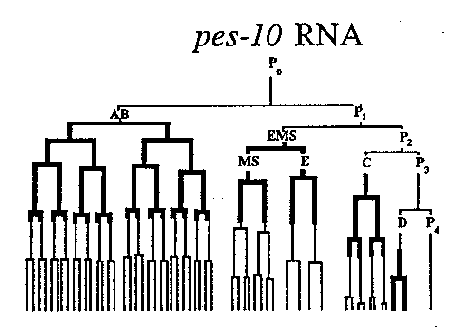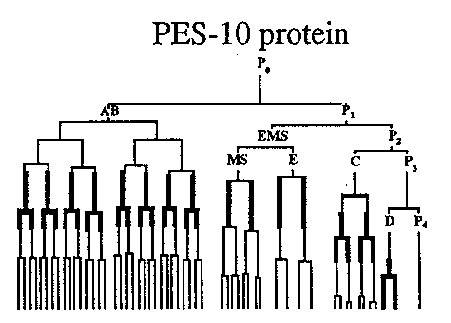Worm Breeder's Gazette 13(3): 33 (June 1, 1994)
These abstracts should not be cited in bibliographies. Material contained herein should be treated as personal communication and should be cited as such only with the consent of the author.
In a previous WBG, we reported the isolation of a lacZ fusion (pGS 15.24) that expresses ß-galactosidase preferentially in the C lineage from the 26-cell stage to the 200-cell stage (WBG 12-5, p35 ). pGS15 .24encodes a translational fusion between a novel gene, which we call pes-1 O(for pattern expression site), and lacZ. The pes-10 gene has the potential to encode a 47kD protein containing an acidic domain. No significant similarities with sequences in GENBANK have been detected so far. To examine the expression pattern of the endogenous pes-10 gene, we have used in situ hybridization to determine the localization of the pes-10 RNA, and immunohistochemistry with polyclonal anti- PES-10 antibodies to determine the localization of the PES-10 protein.
We find that pes-10 RNA is first transcribed in each somatic lineage shortly after separation from the germ lineage. In each lineage, pes-10 RNA continues to be present for 2 to 4 cell cycles before rapid degradation. Because each lineage arises sequentially, pes-10 RNA is present predominantly in only one or two lineages at any specific stage: first in the AB and EMS lineages (4-16-cell stage), then in the C lineage (14-28-cell stage), and finally in the D lineage (28-55-cell stage). pes-10 RNA was never detected in the germ lineage. Absence of transcripts in the germline seems to be a feature common to several early zygotic RNAs (WBG 13-1, p25 ;WBG 13-2, p22 ).
The expression of the PES-10 protein closely follows that of pes-10 RNA. PES-10 protein is first detected in AB and EMS-derived cells (12-24-cell stage), then in C-derived cells (24-30-cell stage) and finally in D-derived cells (30-55-cell stage). In each lineage, the protein appears first cytoplasmic, but becomes predominantly nuclear following cell division.
If pes-10 RNA and protein are expressed in all somatic lineages, why does a pes-10 ::lacZfusion express ß-gal preferentially in the C lineage? We found that the pes-10 -lacZfusion RNA is expressed in all cells where endogenous pes-10 RNA is detected. However, unlike the endogenous pes-10 RNA which quickly becomes cytoplasmic, the pes-10 ::lacZfusion RNA remains nuclear in all lineages until the 26-cell stage, when it becomes cytoplasmic in the C lineage, the only lineage expressing the fusion at that stage. This apparent block in nuclear export (or cytoplasmic instability) has also been observed for other lacZ fusion RNAs, and could be due to the long intron-less coding region of lacZ. These observations demonstrate that ß-gal expression from lacZ fusion constructs can be incomplete in early embryos.
The intriguing expression pattern of the endogenous pes-10 gene suggests that pes-10 may play a unique role in embryogenesis. Indeed, in a survey of transcripts derived from 20 genes expressed during embryogenesis, no transcript was found to be expressed as early and as transiently as pes-10 (WBG 13.1, p25 ).The pes-10 gene maps to the right arm of LGII at the right end of the lin-29 contig. We are currently using genetic tools to investigate the function of pes-10 in embryonic development

